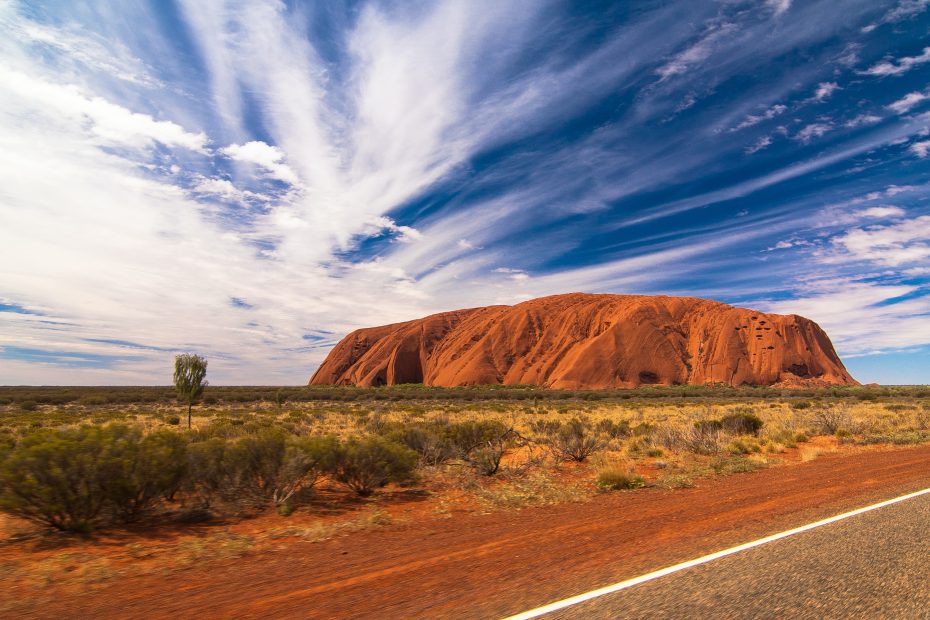Table of Contents
Introduction
Uluru, also known as Ayers Rock, is a massive sandstone rock formation located in Australia’s Red Centre in the Northern Territory. Rising 1,142 feet tall, Uluru is one of Australia’s most recognizable landmarks. The imposing monolith has great cultural significance to the Aboriginal Anangu people, who have inhabited the area for over 30,000 years. Uluru anchors the southern end of Australia’s “Red Heart,” an expansive desert region known for its rusty-hued soil. With its stunning visage and rich indigenous history, Uluru beckons visitors from around the world seeking an authentic Australian experience.
History and Facts about Uluru
The Aboriginals in the area refer to Uluru as a “special place.” In their oral tradition, Uluru was created at the beginning of time by ancestral beings. Geological estimates date the formation of Uluru to over 600 million years ago. The striking rock is made of arkose sandstone, rich in feldspar and quartz. One of the largest monoliths in the world, Uluru measures around 5.8 km long, 2 km wide, and has a total circumference of 9.4 km. Visitors are amazed by the varying hues of Uluru, which change throughout the day from pinkish red to deep burgundy.
Visiting Uluru
The ideal times to visit Uluru are during April and May or September through November, when temperatures are milder. There are excellent viewing spots all around the rock. Alternatively, helicopter tours provide a bird’s-eye perspective. As a site sacred to Aboriginal cultures, visitors are asked to refrain from climbing Uluru out of respect. Instead, trails at its base lead to caves, waterholes, and ancient rock paintings. Allow ample time to walk around and witness the rock from different angles. Watching the sunrise or sunset cast shadows and tint Uluru’s surface is a highlight.
Climbing Uluru
Climbing Uluru has been a contentious issue. Though historically open for climbing, pathways up the rock have been closed intermittently due to high winds and safety concerns. Out of respect for the site’s cultural significance to the Anangu, climbing Uluru has been permanently banned since 2019, though some still argue for reopening it. There are substantial fines for anyone caught climbing. While controversial, keeping visitors off Uluru is important to preserve the rock and Aboriginal heritage.
Uluru at Sunrise and Sunset
Many say the best times to appreciate Uluru’s grandeur are at sunrise and sunset. In the soft glow of daybreak, the rock radiates fiery red hues. Prime viewing spots are at the sunrise viewing area or from a distance at Kata Tjuta. As the sun dips below the horizon, Uluru illuminates brilliantly, casting an iridescent red glow. The Changing Colors viewing area offers panoramic sunset views. Bring your camera – these fleeting moments are capture-worthy!
Activities around Uluru
In addition to photographing Uluru, visitors can ride a camel, trek by mountain bike, browse local galleries, or dine under the stars at Sounds of Silence. The Red Centre offers many options for active travelers who want to fully experience the otherworldly landscape.
Accommodation
Camping allows an immersive experience, with campgrounds available within the national park. Additionally, Ayers Rock Resort offers luxury hotels, restaurants, and an aquatic center. The neighboring town Yulara also provides hotels, hostels, and campsites. Most visitors stay at least 2 nights to properly explore Uluru and Kata Tjuta.
Traveling to Uluru
The nearest major airport is Ayers Rock Airport, located 10 km from Uluru. Flights arrive daily from major cities. Renting a car allows flexibility in exploring the area. Daily coach tours from Alice Springs are another option. Organized tours pick up visitors from area resorts or campsites. Allow at least 3 days to see top area attractions.
Conservation Efforts
Environmental factors and throngs of tourists threaten Uluru’s fragile desert ecosystem. Conservation efforts aim to balance visitation with sustainable practices like proper waste removal and restricted vehicle access. Preserving Aboriginal heritage and culture is also a priority. Educational programs help instill respect for their spiritual connection to the land.
Uluru’s Significance for Australia
As the nation’s most recognizable landmark, Uluru is considered an Australian icon and point of pride. It provides a touchstone linking Aboriginal history with the country’s modern national identity. Uluru also attracts over 400,000 annual visitors, driving tourism to the Red Centre. This natural wonder continues inspiring all who gaze upon its towering primordial presence.
Conclusion
With its rich indigenous history, vibrant colors, and extraordinary natural beauty, Uluru is a sight that will amaze you. Witnessing the spectacular sunrises, sunsets, and shifting lights across its landscape is an unforgettable experience. As Australia’s spiritual and cultural heart, Uluru represents the beauty and mystery of the continent’s ancient interior. Any visit down under is incomplete without seeing the famed Red Centre and its dazzling blood-red monolith anchoring the horizon. When you make the pilgrimage to Uluru, prepare to be awestruck by Australia’s most stunning natural wonder.
FAQs
Q: How did Uluru form?
A: Uluru formed over 600 million years ago from sediments washing down from an inland sea. Over time, these sediments consolidated and pressed into rock.
Q: Can you climb Uluru?
A: Climbing Uluru is prohibited as it is a sacred site to indigenous Anangu people. There are substantial fines for anyone caught climbing.
Q: Where is the best place to view Uluru?
A: Excellent viewing spots include the sunrise viewing area, the sunset Changing Colors vista, and Kata Tjuta overlook. Prime times are sunrise and sunset when Uluru becomes iridescent.
Q: What is the weather like at Uluru?
A: The climate at Uluru is hot and dry desert. The coolest months are June and July while the hottest are December and January. Temperatures range from 46°F to 113°F.
Q: How long should I spend at Uluru?
A: Most itineraries recommend staying 2-3 days to properly visit Uluru and Kata Tjuta as well as participate in activities like sunrise viewing. Allow ample time to walk around the rock’s base.
